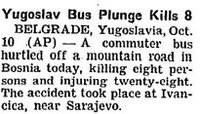The Bus Plunge Genre
The bus plunge genre? Slate's Jack Shafer laments its 25-30 year absence at the New York Times. The story is lovingly illustrated by bus plunge clippings from Times past, like this one from October 11, 1960: And this one from September 1, 1956:
And this one from September 1, 1956: The bus plunge story was a tragic type of space filler from a time when the typesetting of a daily wasn't so simple. They all but disappeared when digital methods made typesetting more exacting and predictable.
The bus plunge story was a tragic type of space filler from a time when the typesetting of a daily wasn't so simple. They all but disappeared when digital methods made typesetting more exacting and predictable.
They're real stories -- buses plummeting off cliffs are surprisingly common, even today. There's a website that gleefully follows the latest stories. It boasts a "plunge of the month" (16 singles club members dead in Israel), an interview with a plunge driver (via the Associated Press), and lots of bad puns.
A writer named Tom Miller asked Slate's Shafer to investigate the genre. Miller had written about bus plunges in a travel book about Panama in the 80s. Shafer recalls Miller's list of the elements all plunge stories should contain:
Jack Shafer concludes:
 And this one from September 1, 1956:
And this one from September 1, 1956: The bus plunge story was a tragic type of space filler from a time when the typesetting of a daily wasn't so simple. They all but disappeared when digital methods made typesetting more exacting and predictable.
The bus plunge story was a tragic type of space filler from a time when the typesetting of a daily wasn't so simple. They all but disappeared when digital methods made typesetting more exacting and predictable. They're real stories -- buses plummeting off cliffs are surprisingly common, even today. There's a website that gleefully follows the latest stories. It boasts a "plunge of the month" (16 singles club members dead in Israel), an interview with a plunge driver (via the Associated Press), and lots of bad puns.
A writer named Tom Miller asked Slate's Shafer to investigate the genre. Miller had written about bus plunges in a travel book about Panama in the 80s. Shafer recalls Miller's list of the elements all plunge stories should contain:
Plunge should appear in the hed; the piece should be only a couple of sentences long; and it should "include the number feared dead, the identity of any group on board" -- a soccer team, church choir, or students -- "as well as the distance of the plunge from the capital city." The words ravine or gorge should appear.Shafer tracked down a retired Times editor, Allan M. Siegal, who had a fondness for bus plunge stories:
"The great challenge was to edit those things as short as they could be and still have them make sense," Siegal says. Great acclaim came to the editor who could artfully reduce wire stories to their absolute essence. One of Siegal's favorite K-heds [a headline plus one paragraph], which ran in the Times in the 1950s, read in its entirety:Apparently no one remembers the headline.
Most snails are both male and female, according to the Associated Press.
Jack Shafer concludes:
Everybody claims to have a cure for what ails the modern newspaper: more color, better printing, better graphics, more attitude in reporting, less attitude in reporting, more local coverage, punchier articles, and on and on. Am I the only one who finds the layouts of today's newspapers to be too symmetrical, too sterile, and too predictable? I won't pretend it's a magic potion, but if I ran a daily, I'd fleck it with random news-wire shorts: freighter sinkings, strange statistics, diplomatic postings, "News of the Weird"-type reports, industrial accidents, animal facts, and, yes, bus plunges. Lots of bus plunges.The stories make a sick sort of poetry. The need to edit them to their essential bits and the formulaic style of the bus plunge short makes them macabre in their brevity, banal in their repetition, and comedic in their tragedy. Siegal justifies his soft spot for the bus plunge k-hed:
"It was more self-parody than anything else," Siegal says. "It was a very low-key, harmless parody of the stilted language characteristic of tightly formatted headlines."Am I totally off-base in calling this poetry? Yes and no. It's not in the information these stories convey, but in the way I'm reading them. Call it found poetry. I argue that they become poetry when I start reading them for the way they are written and constructed, and not for the news they offer. Here's one more, this time it's from the BBC -- and it's from late last October. The original story was 120 words in six short paragraphs. I've edited down to a managable k-hed, but I kept the original headline:
India bus plunge kills 21 peoplePoetry, sweet poetry.
A bus carrying 63 people in northeastern India plunged into the Teesta river on its way to the town of Gangtok in the mountain state of Sikkim. Villagers managed to rescue 42 of the passengers.


1 Comments:
Jack Shafer followed up on the 'Bus Plunge' story with reader comments -- there were lots.
A reader shared his favorite K-hed from a Philadephia paper:
No Blood in Ants
Ants have no blood.
That's the entire story. Beautiful.
And apparently National Lampoon used to run lots of bus plunge shorts.
Read Shafer's follow-up here on Slate.
Post a Comment
<< Home